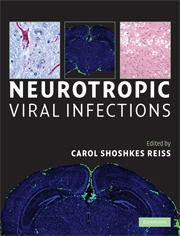Book contents
- Frontmatter
- Contents
- List of contributors
- Foreword
- Preface and acknowledgments
- Section I Introduction: RNA viruses
- Section II Introduction: retroviruses, DNA viruses, and prions
- Section III Introduction: immunity, diagnosis, vector, and beneficial uses of neurotropic viruses
- 14 Innate immunity in viral encephalitis
- 15 Role of Toll-like receptors in neurotropic viral infections
- 16 Neuroendocrine-immune interactions in neurotropic viral infections
- 17 Epidemiology of viral encephalitis
- 18 Pathogen surveillance and discovery
- 19 Clinical management of viral encephalitis
- 20 Influences of arthropod vectors on encephalitic arboviruses
- 21 The role of bats as reservoir hosts of emerging neurological viruses
- 22 Viral oncolysis of glioblastoma
- 23 Viral gene therapy for central nervous system diseases
- Index
- Plate section
- References
20 - Influences of arthropod vectors on encephalitic arboviruses
from Section III - Introduction: immunity, diagnosis, vector, and beneficial uses of neurotropic viruses
Published online by Cambridge University Press: 22 August 2009
- Frontmatter
- Contents
- List of contributors
- Foreword
- Preface and acknowledgments
- Section I Introduction: RNA viruses
- Section II Introduction: retroviruses, DNA viruses, and prions
- Section III Introduction: immunity, diagnosis, vector, and beneficial uses of neurotropic viruses
- 14 Innate immunity in viral encephalitis
- 15 Role of Toll-like receptors in neurotropic viral infections
- 16 Neuroendocrine-immune interactions in neurotropic viral infections
- 17 Epidemiology of viral encephalitis
- 18 Pathogen surveillance and discovery
- 19 Clinical management of viral encephalitis
- 20 Influences of arthropod vectors on encephalitic arboviruses
- 21 The role of bats as reservoir hosts of emerging neurological viruses
- 22 Viral oncolysis of glioblastoma
- 23 Viral gene therapy for central nervous system diseases
- Index
- Plate section
- References
Summary
Introduction
Arthropod-borne viruses (arboviruses) are found in several virus families including Bunyaviridae, Togaviridae, Flaviviridae, Orthomyxoviridae, Rhabdoviridae, and Reoviridae. Many are not pathogenic for their natural vertebrate hosts, but those that do cause disease are often associated with a broad range of clinical manifestations. For example, most human West Nile virus (WNV) infections are asymptomatic, but some progress rapidly to a fatal encephalitic outcome [1]. Although this variability can be partly correlated with host characteristics (e.g., age and immune status) interactions between the virus and the vertebrate host that lead to disease are often complex and poorly understood. For a particular arbovirus, different species of vertebrate may play different roles in the viral maintenance and transmission cycle. It is not well understood why some species are apparently genetically resistant to infection (i.e., not a host for replication) whereas others are highly susceptible (i.e., readily infected following exposure to a low viral dose). Maintenance vertebrate hosts that play a critical role in virus amplification and the infection of vectors must produce a sufficiently high titer of virus in the blood (viremia) to ensure that the recipient vector becomes infected. This is usually referred to as the infection threshold and may be accompanied by clinical symptoms such as fever, but it does not necessarily correlate with disease severity. Conversely, hosts that do not produce threshold viremic levels sufficient to infect vectors (so-called “dead-end” hosts) may succumb to infection.
- Type
- Chapter
- Information
- Neurotropic Viral Infections , pp. 362 - 381Publisher: Cambridge University PressPrint publication year: 2008
References
- 1
- Cited by



